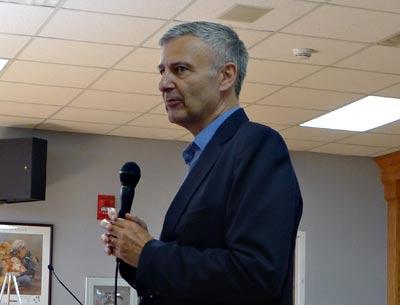Urge Village to Go Green

East Hampton Village should create and adopt a resolution pledging to meet its energy needs through renewable sources and reducing its energy consumption, Frank Dalene, chairman of East Hampton Town’s energy sustainability advisory committee, told the village board at its meeting on Friday.
Declaring that “our work has only begun,” Mr. Dalene outlined the town’s recently-adopted goal to meet 100 percent of communitywide electricity needs with renewable energy sources by 2020 and the equivalent of 100 percent of economywide energy needs, such as electricity, heating, and transportation, with renewable energy sources by 2030.
Richard Lawler, a village board member, introduced Mr. Dalene along with John Botos, of the town’s Natural Resources Department, and Gordian Raacke, executive director of Renewable Energy Long Island. All, including Mr. Lawler, are members of the energy sustainability advisory committee.
“We need to dramatically reduce greenhouse gas emissions coming from power and other sectors” in order to mitigate disastrous consequences of climate change, Mr. Raacke told the board. An 80-to-90-percent reduction in those emissions is urgent, he said.
Renewable-energy technologies have advanced sufficiently to be both efficient and cost-effective, Mr. Dalene said, making the town’s goals realistic and achievable. Should proposed installations, including solar farms on town-owned sites and the Deepwater One wind farm to be situated 30 miles offshore, be completed and operational, “we will have more than achieved those goals,” he said. On an individual level, federal, state, and local initiatives, such as financing programs through the New York State Energy Research and Development Authority, make installation of a solar panel array affordable to homeowners, he added.
Mr. Botos told the board of the town’s outreach plans, which he said will include engaging the public through an “unplug” campaign and a logo design competition in the schools. A section devoted to energy and reducing consumption will be added to the town’s website, he said. He also discussed a statewide initiative in which homeowners can obtain a free energy audit, which includes an analysis and recommendations on reducing energy consumption and waste, and programs including a fast-track solar permitting process and code changes that will speed electric-vehicle supply permits for homeowners. An electric-vehicle charging station should be in place at Town Hall in a month’s time, he said, “to show that the government is embracing this technology.”
“I speak for the entire board when I say we support your goals,” Mr. Lawler told the men, adding that the village has installed solar panels on three of its buildings, reducing its electricity bills by half, and purchased some electric vehicles. “We are in sync with your goals,” he said.
Mayor Paul F. Rickenbach Jr. asked for an opportunity to look at the proposal in depth. “I assure you, we will somehow come up with a favorable accord,” he said.
In other news from the meeting, public hearings on three proposed laws garnered no public comment and the laws were adopted. One prohibits parking on the north side of Newtown Lane from the intersection of Conklin Terrace west for 20 feet. Another limits parking on the north side of Newtown Lane between Sherrill Road and Conklin Terrace, and from the point 20 feet west of Conklin Terrace west for 300 feet, to two hours between 8 a.m. and 7 p.m.
The third law amends a section of code pertaining to preservation of dunes, allowing for the placement of beach-compatible sand on land within 150 feet of the south edge of the beach grass along the ocean. Otherwise, digging, dredging, or excavating, or depositing fill or other material in that area is prohibited. The law also prohibits clearing, removing, uprooting, burying, or otherwise damaging vegetation, or replacing it with lawn, sod, or turf in that area. However, the amendment provides an exemption for the construction of elevated pedestrian walkways for noncommercial access to the beach.
